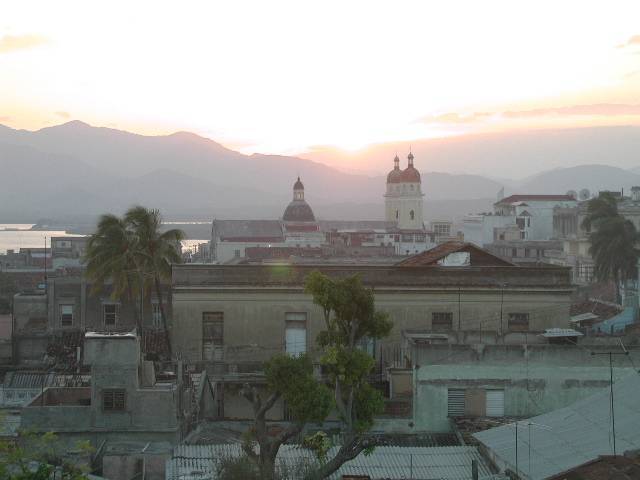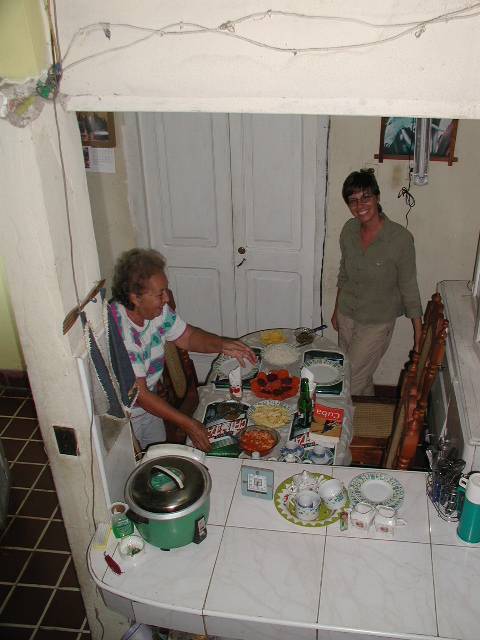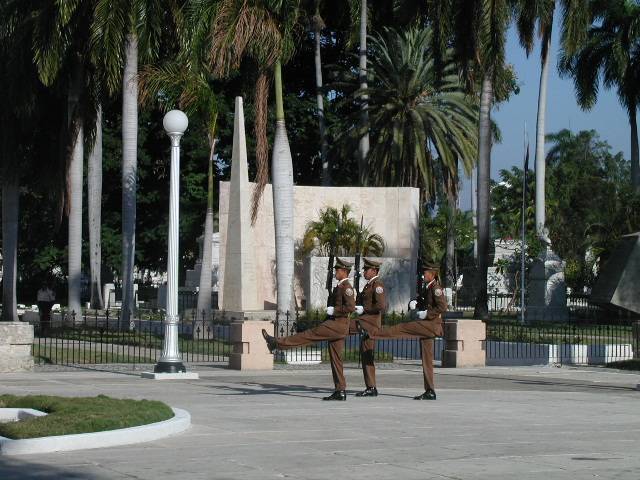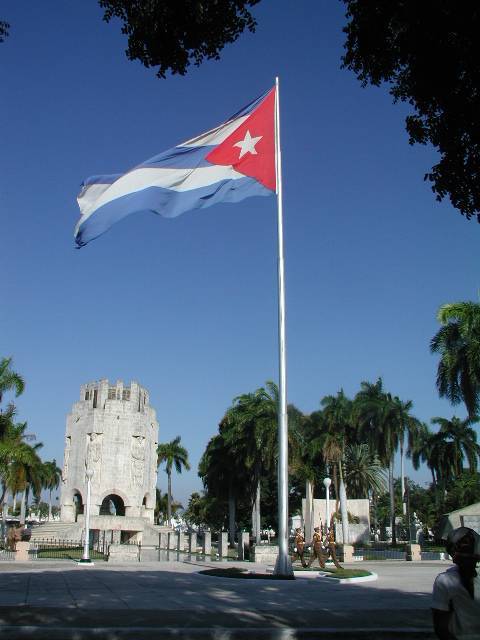|
Puerto Vita, Gibara,
Santiago de Cuba 10th
- 15th April 2004 |
|
Finally approved by all the authorities in
Puerto Vita to be let loose amongst the Cuban population, we decided to
explore the village near the marina. During our walk through the
one-street town of Vita, we were quickly approached by Severino, a local
fisherman. After some confusion, we realised he was offering us
the chance to eat dinner at his home that evening. The practice
of offering meals and accommodation to travellers in their homes is very
common amongst the Cuban population, who are always keen for an opportunity
to earn some US dollars. Some of the establishments are licensed
and have a baffling amount of paperwork to complete and high taxes to pay, others
are unlicensed.
The day-to-day economy of Cuba runs with two
currencies, the Cuban Peso and the US dollar (sometimes also substituted
with the confusingly named "Interchangeable Peso", which has the
same value as a dollar but is worthless outside Cuba).
Cuban salaries are paid in Cuban pesos and the dollar equivalent of the
average professional's monthly salary, for say a doctor or professor, is
less than the cost of renting a bed-and-breakfast room in a house overnight
($20). Hence the Cuban's enthusiasm for working with
tourists. Apart from staple foods bought at the market and for
Cubans only, transport, some bars and restaurants, everything else has to be
purchased in dollars.
Severino took us to his home for a cup of
strong Cuban coffee and introduced us to his wife Yousy. We
returned that evening to sample authentic Cuban food. A typical
meal is usually pork, chicken or fish served always with rice and beans and
as it seemed to be tomato season in Cuba, well that was almost all that was
for sale in the markets anyway, a tomato salad. Eating in
the so-called "paladors", the local word for a house where meals
are served to visitors, is an excellent way to catch a glimpse of the Cuban
lifestyle and chat to the locals.
|

Dinner at Severino and
Yousy's house.
|
Phil made friends with the workers at the
marina, while he was fishing from the dock. The security guard
managed to persuade him to part with one of his precious lures and whilst
demonstrating to him how it worked, Phil unexpectedly hooked a barracuda
too, so the guard was doubly happy when he left with a lure and his supper!
We'd been a bit disappointed that our first
landfall in Cuba was in a spot so remote from towns of any size. It
seems that most of the tourist resorts are located in out-of-the way
locations. We decided to head further west up the north coast as
quickly as possible. Our next port of call was Gibara, a town about 10
miles west of Vita. The port was supposed to be OK for calm weather
and as there had been no wind for days, we hoped it would be
OK.
|
|
We anchored in the bay, which seemed fine and
within minutes the Port Captain arrived in a rowing boat manned by a local
fisherman. Each time you arrive in or leave a Cuban port, the
authorities (who became known as "the men in green") have to check
your documents, stamp your cruising permit and make notes on the document
about whether you've been good whilst in their port. The
cruising permit and tourist visa are, in the words of the officials who
cleared us in to Cuba at Vita, "good everywhere in
Cuba". However, we quickly realised that the port officials
on the north coast seemed to work from a manual entitled "30 reasons to
keep the Gringos aboard their boats"! In Baracoa reason one
had been used ("This is not a port of entry, you can't go
ashore). Here we encountered reason number two (No boats at anchor -
except local ones of course - to be left unattended)!
First the Port Captain asked why we were
stopping in Gibara if our papers said we were going to Havana. We replied
that we wanted to visit the town, to see Cuba. He asked who would be looking
after the boat when we went ashore. We were very puzzled as in every place
we've been to, it hasn't been a problem to leave the boat at anchor for a
trip ashore, what would be the point of stopping otherwise? After
several minutes of debate, he shrugged his shoulders and left, it seemed we
would be allowed ashore after all. We needn't have bothered having the
argument because as soon as he left, the wind picked up to a constant 25
knots, with gusts to 35 and swell coming into the bay to accompany it.
If it had been safe enough to get up the anchor, we'd have left with or
without our cruising permit being stamped. We couldn't contact the Port
Captain as he had no VHF radio. However, in the end we took anchor
watch all afternoon, the anchor held fine but it was quite scary. By evening
the wind died down and the swell reduced a little, then we ended up beam on
to it all night, so didn't get much rest. Our visit to Gibara was not
a great success. When the Port Captain returned at the appointed
departure time of 7 am, he smugly asked if we enjoyed our visit to the town.
Hmm.
|

|
|
The weather forecast was for unsettled weather
with strong winds for the next week, so we decided our best option was to
return to the protected port of Vita, anchor there and hire a car to visit
some of the parts of Cuba we'd missed by hire car instead. On
arrival we were greeted like old friends. Of course we had to pay £7
a night for the privilege of using our own anchor near the marina and once
they heard our plan to tour by car, reason 2 from the manual was used again
to make us move the boat back from the anchorage into the marina before we
left. The nice lady in the marina did, however, only
charge us the same price as for anchoring, which helped.
|
|
As soon as we left the marina for our three day
tour with the hire car, we encountered our first Cuban traffic jam - an ox
cart stuck across the road! We made our way along surprisingly
good roads through Holguin to Santiago de Cuba, and quickly decided we were
glad we'd opted for the luxury of the hire car, instead of relying on public
transport. The poor locals seemed to travel incredible distances
squashed in the back of trucks, usually with no seats or protection from the
baking sun or rain. Throughout our trip, we passed locals
hopefully waiting at the side of the road, in large crowds at major
junctions, for some form of transport to arrive. It seemed that the
Cubans travelling overland have to use the same flexible time planning
system as we do sailing and need even more patience! The option
of travelling by train may seem more desirable once they manage to buy a
ticket, which can apparently take anything from three days to a
fortnight! Tourists, of course, are whisked to the front of the queue
as the dollar price for tickets is the same as the peso price (i.e. 26 times
more expensive).
|

Cuban Traffic Jam
|

Normal public transport for
locals
|

De-luxe public transport
for locals
|
|
It was novel to travel along roads not littered
by advertising billboards, however each small settlement we passed seemed to
have put a great deal of effort into a roadside display demonstrating their
enthusiasm for the revolution, sometimes in the form of posters of
revolutionary heroes, often with gardens alongside.
We soon reached Santiago de Cuba and the last
section of the journey was on a "motorway".
Finding the motorway was tricky, as there were no road signs at all
indicating the access roads but once on the six lane highway we were able to
travel quickly provided we kept a good lookout for cyclists and horses,
which were often travelling the wrong way up the carriageway.
|

Santiago's queue for train
tickets
|

Sunset view from the
terrace of our home in Santiago de Cuba
|
In Santiago's busy streets we tried to find one
of the "casas particuliares" or bed and breakfasts, we'd been told
about. We found ourselves heading the wrong way up a one-way
street and were stopped luckily not by the police but by Michel, who spoke
excellent English.
As luck would have it, his mother-in-law
Elvira also had a room to rent, just around the corner and we decided to
park up the car and stay there, as it was just a few minutes away on foot
from the centre of the city. Before we headed out to see the city, we
were able meet Michel's brother-in-law, a kidney specialist, who earns the
equivalent of $15 a month. Our room was $20 for the
night. Michel spoke excellent English, being an English
Professor but preferred to work in the dollar based tourist industry, giving
tours when cruise ships visit the city.
|
|
Michel took us for a walk around the centre of
Santiago to help us get our bearings and showed us the main landmarks, the
bars where you could dance to local music, the main square called Parque
Cespedes, full of tourists and hustlers, where you could see the beautiful
cathedral and the town hall where Fidel Castro made a famous speech after
the Revolution.
|
|

Elvira preparing our dinner
|

One of Santiago's many bars with live
music and dancing
|
|
As the sun set that evening it was fascinating
to sit on the terrace above the house and watch a cross-section of Cuban
life being lived on the roof terraces of the houses nearby, girls rehearsing
a dance on one roof, people exercising on another, locals doing the same as
us and just watching the world go by.
Next morning we were awakened by loud
screaming and on investigating discovered that the neighbours were
butchering their pig on the roof. Michel was interested
that we were so surprised by this and asked, "Don't you slaughter your
pigs on the roof of your house in cities in Wales?" Our
reply, "Erm, no, not allowed", left him puzzled.
|

Fresh bacon for breakfast
anyone??
|
|

Changing of the guard at
the mausoleum
|

|
|
Before we left the city to continue our tour by
car, Michel took us to the famous cemetery, Cemetario Santa Ifigenia, to see
the impressive changing of the guard ceremony at the mausoleum of the
revolutionary hero José Martí.
We managed to cram in a visit to the Bacardi
museum and the Carnival Museum, where we augmented our musical instrument
collection aboard with some Cuban maracas and claves. Too
soon it was time to leave Santiago de Cuba and continue our adventure by
road.
|











